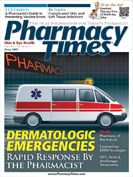Publication
Article
Pharmacy Times
A Check-up Visit to the Pharmacy Can Save the Day
Author(s):
A patient with hypertension presents a drug regimen that includes a total of 9 medications.
BROWN BAG CONSULT

A patient with hypertension presents a drug regimen that includes a total of 9 medications.
Patients with chronic conditions may be at a higher risk for medication-related errors. These patients take a number of different medications, see a variety of health care providers, and may use more than 1 pharmacy. In addition, these patients may experience short- or long-term changes in their health that precipitate maintenance therapy adjustments.
The pharmacist is a provider within the community with whom a patient may communicate on a consistent and frequent basis to help provide necessary followup care. Refill medication counseling is an excellent opportunity for pharmacists to identify vulnerable patients. Brown bag consults allow pharmacists to offer extended counseling, including medication therapy management (MTM). They are also an essential safety and educational tool the pharmacist can use to instill quality in the health care system.
A brown bag consult requires patients to gather all of their current medications, including any OTC, mail order, or herbal products, for review with the pharmacist. The pharmacist can help identify any potential problems or concerns that may require additional follow-up with the prescriber by offering an MTM session.
During a consult, pharmacists should compare the medications in hand to those listed on a patient’s pharmacy profile. They should check for duplication of therapy, verify the correct dosage strengths and frequencies, and identify any interactions. The pharmacist should also note if any of the medications are outdated or discontinued. Providing an updated medication list to the patient at the end of the brown bag consult helps ensure that the patient will be able to share accurate information about their medications with any provider.
Brown bag consults are not only helpful to patients, but are also a useful safety tool for pharmacists to help access patient compliance. They can show how well patients understand their conditions along with the purpose and directions associated with their medications. Brown bag consults provide insight into a patient’s lifestyle and quality of care. They also provide the opportunity to develop the patient—pharmacist relationship to help guarantee loyalty, trust, medical error prevention, and overall better individualized services.
Brown Bag Consult: Hypertension
CG is a 68-year-old woman who is a relatively new customer to your pharmacy. She volunteers at the local community hospital, which has helped her become more aware of her disease states and medications. You notice her concern by the increased number of questions during your counseling sessions, specifically related to her diet and hypertension treatment.
Today, CG stops in the pharmacy to pick up her new prescription for levothyroxine. As you counsel her on the levothyroxine, you explain that because she is treating multiple chronic disease states, she would be a great candidate to participate in a brown bag session. She sets up an appointment to meet with you tomorrow.
To prepare for the session, you pull up CG’s pharmacy profile so you are able to compare it with what is in her brown bag. Her profile includes:
- Enalapril 5 mg once daily
- Furosemide 40 mg once daily every morning
- Atorvastatin 20 mg once daily every evening
- Fenofibric acid 135 mg once daily every evening
- Levothyroxine 25 mcg once daily every morning
- Esomeprazole 40 mg once daily
CG arrives the next day for her appointment with a pen and paper, ready to create a list. She empties her brown bag and reveals these additional medications:
- Aspirin 325 mg once daily
- Calcium carbonate 1000 mg once daily
- Adult multivitamin once daily
- OTC omeprazole 20 mg once daily
As you review the medications for accuracy, CG tells you in confidence that with her limited budget, she is not always able to maintain compliance or loyalty to 1 pharmacy. CG also has been monitoring her blood pressure more frequently and has questions about goals and diet. Because of this, she is very interested in participating in the MTM session you offer as follow-up.
Hypertension is an independent risk factor for coronary artery disease, stroke, and renal failure. It is important to discuss blood pressure goals, dietary habits, and medication regimens during counseling and brown bag consults. Keeping this in mind, how would you properly review CG’s medication profile and what advice could you offer her during the brown bag consult?
How would you advise CG? To weigh in, leave a comment on this article. Advice for CG:
Pharmacists may develop slightly different plans for some of the issues presented by patient CG. After conducting a brown bag or MTM session, it is recommended that pharmacists immediately take action on recommendations by communicating with the patient and their providers. Follow-up communications are paramount in gaining trust and respect for the entire pharmacy team.
With respect to CG’s brown bag session, the recommendations listed below were made. These recommendations can be developed further and discussed during CG’s more exhaustive MTM session. In applying these recommendations, pharmacists should keep in mind that every brown bag and MTM session is individualized to maximize patient quality of life.
1.) If your pharmacy offers a clinic or immunization services, ask CG if she is up-to-date on her flu and pneumonia vaccinations.
2.) Use of 5 or more medications increases the risk of adverse drug reactions and may hinder adherence. Make certain that CG’s required labs are updated and each of her providers has copies. In addition, make certain you check her TSH, cholesterol, bone mineral density, renal, and liver function levels.
3.) CG expressed concern about her blood pressure goals. You were able to take a reading and the best reading out of three averaged 143/96 mm Hg. CG’s goal is <130/80 mm Hg. There is room for improvement. At this point you can recommend some diet and therapy changes. Reinforce the DASH diet and increase anti-hypertensive drug strengths to achieve CG’s blood pressure goals. Some possible suggestions include enalapril change (increase or discontinue and change therapy if she complains of cough) and change in furosemide therapy (discontinue furosemide 40 mg qday and change to chlorthalidone 25mg qday)
4.) Counsel CG on proper use of medication. Make certain that she is separating her levothyroxine from her daily MVI and calcium supplement.
5.) Suggest to CG that she use a lower dose 81 mg enteric coated aspirin instead of the standard 325 mg aspirin for cardiovascular prophylaxis as recommended by her cardiologist.
6.) CG is worried about cost issues. Make certain that she has all necessary co-pay cards on file for branded drugs for which she is eligible.
7.) Duplicate therapy with OTC omeprazole and prescription esomeprazole is a concern. Notify CG's prescribing provider and ask which one they would like discontinued. CG is taking daily calcium supplements. Remind the provider that PPI’s can decrease calcium supplement absorption and therefore increase fracture risk.
Dr. Drury works as a clinical pharmacy specialist in Chicago, Illinois, and Milwaukee, Wisconsin. She earned her doctor of pharmacy from Midwestern University College of Pharmacy in 2007. In addition to her current work, she is a blogger for PharmacyTimes.com and a speaker for Abbott Pharmaceuticals.








